依據歐盟施行的個人資料保護法,我們致力於保護您的個人資料並提供您對個人資料的掌握。
按一下「全部接受」,代表您允許我們置放 Cookie 來提升您在本網站上的使用體驗、協助我們分析網站效能和使用狀況,以及讓我們投放相關聯的行銷內容。您可以在下方管理 Cookie 設定。 按一下「確認」即代表您同意採用目前的設定。
2023/02/16:
About Bikelight
Why do bicycle front lights need to meet the German bicycle lighting equipment testing standard (StVZO)?

Only a few countries around the world regulate bicycle front lights, and among them, the strictest regulations come from Germany. Therefore, in the minds of many cyclists, "compliance with German standards equals high safety and efficiency," making it a goal pursued by various major brands as well. What are the testing standards for German bicycle lighting equipment?
1. Bicycle lights must not have a flashing function. The front light of a bicycle is for illumination purposes, and flashing can actually lead to visual fatigue.
2. Bicycle lights must have a low battery indicator.
3. During testing conditions, the bicycle light should be continuously illuminated for one hour before testing begins, and there should be no low battery warning during this time.
4. The design of the brightness cut-off line and the distribution of light for bicycle lights should be even to avoid excessive concentration that may affect the visibility of oncoming cyclists.Additionally, German road safety regulations also require that bicycle lighting equipment should provide a minimum illuminance of 10 Lux at a distance of at least 10 meters.
2. Bicycle lights must have a low battery indicator.
3. During testing conditions, the bicycle light should be continuously illuminated for one hour before testing begins, and there should be no low battery warning during this time.
4. The design of the brightness cut-off line and the distribution of light for bicycle lights should be even to avoid excessive concentration that may affect the visibility of oncoming cyclists.Additionally, German road safety regulations also require that bicycle lighting equipment should provide a minimum illuminance of 10 Lux at a distance of at least 10 meters.



